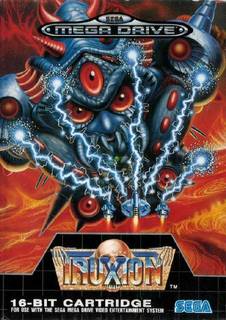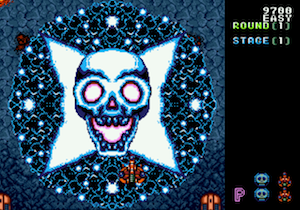
As an early MegaDrive title, I remember its review back in t'day in jolly old Computer and Video Games. In common with nearly all of the initial crop of games, Tatsujin as we knew it then walked away with a massive pile of accolades. Remember, these were the days when replication of the arcade experience was the sine qua non of action-based gaming. The tiny number of screen shots jumped off the page and looked like something I'd only ever see at the sadly-missed American Adventure up the road. The graphics were crisp and crapped over all the shooters available on the 16-bit home computers, and the bosses were simply huge. I think this was the moment when I realised that the pennies I had hitherto put away for an Amiga might best go on Sega's machine instead - even though the official release was still over a year away.
Summer of 1991 came round and I finally had cash enough to sink into a MegaDrive. I started off with two games and spent the next year or so (very) slowly building up a collection. Truxton as it was now styled for Western audiences by this time wasn't something I particularly fancied, until the purveyor of cheapo console games on Ripley market introduce a swapping service. For a complete game and a fiver, you could have a new game. This is how I got my copy, stupidly swapping my original, complete and pristine copy of Star Control for it. Duh. And you know what, I was disappointed.

Not this time, alas. Those first impressions formed 20 years ago all came back when it flashed up on my MegaDrive. The format, fly up a forced scrolling screen dispatching waves of enemies can be quite satisfying, but in Truxton's case it is marred by a litany of cheap deaths. Baddies suddenly appearing up your backside with little chance to avoid them. Exploding light bulbs (yes, really) that throw shards of death around the screen while trying to battle hordes of aliens are annoying. And, occasionally, those evil sods off screen throwing a bullet or two in your direction. This is partially compensated by the weaponry, of which there are three types obtained through power ups. The standard spread shot eventually develops a shield of bullets that prevent any kamikaze sneak attacks from the rear. But not helpful against the light bulbs. The "green weapon" is the most powerful but concentrates your fire in a strictly narrow column of death to the front of your craft. Excellent for bosses, not ideal for the rest of the level where enemies pop up from here, there and everywhere. And lastly there is the most awesome looking weapon, the lightning. On the screenshots it looks extremely impressive, and powered up fully five columns of electrical energy stream out to encompass almost the entirety of your screen. Problems? Sides remain vulnerable, the bolts can obscure exploding enemies, and there are nefarious mid-level bosses that use the beams to home in on your craft. Though word has to go to the Truxton smart bomb, which remains the most awesomely ostentatious explosion to grace a 16-bit machine.
This might sound like a whinge (and it is), but it does make for a very frustrating experience. One moment you're basking in the near-invulnerability of total destructive power, and one cheap death reduces you back to a sluggish, underpowered vulnerable nonsense. Under these circumstances, you're sure to be less X-wing, more ex-wing. Yes, it's one of them. Truxton also has the annoying Toaplan characteristic of offering speed ups to the point of uncontrollability, making it nigh on impossible to effectively avoid enemy fire without careening into something else.

As games go, Truxton is now a museum piece. Worth a whirl certainly, but rapidly eclipsed at the time by other vertically scrolling fare Super Aleste as well as Toaplan's subsequent efforts on the MegaDrive.
No comments:
Post a Comment